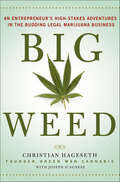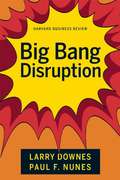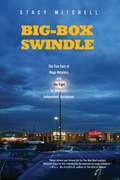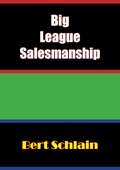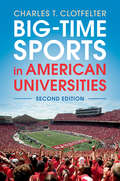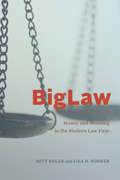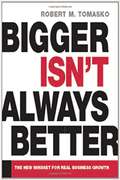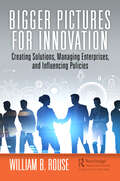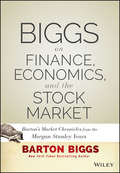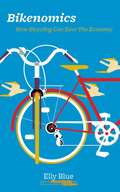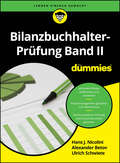- Table View
- List View
Big Weed: An Entrepreneur's High-Stakes Adventures in the Budding Legal Marijuana Business
by Joseph D'Agnese Christian HagesethBig Weed presents an inside look at the legal marijuana industry and the huge economy it's creating—from the founder of Green Man Cannabis, one of the fastest-growing marijuana producers in the country.Marijuana legalization is the hottest story in the US today. More than 20 states have authorized sales in some form; Denver has more legal marijuana dispensaries than Starbucks franchises. We are witnessing the dawn of a new industry. And like the early days of gourmet coffee chains, the rules and players are being established on the fly.Christian Hageseth is the face of the revolution-an entrepreneur and father of three who worked in the white-collar professional world for 20 years before opening his first dispensary. The Founder and Chairman of Green Man Cannabis, the fastest-growing legalized marijuana company in the country, he's the perfect tour guide through the wild frontier, where police hardly know what laws to enforce, or parents what to tell their kids. He paints a colorful picture not only of how he got into the business, but of the big interests that are eager to do the same-namely Philip Morris, Monsanto and a who's who of Big Pharma. He predicts a future where the marijuana market splits in two: the high-end, artisanal market, supplied by individual growers and small farms, and the mass market, covered by the cigarette giants and anyone bold enough to compete with them. Much like beer and coffee, your brand of weed will be just one more reflection of your lifestyle. It's an entrepreneur's dream, and Hageseth invites us along in Big Weed as he pitches skeptical investors, negotiates a shaggy cast of colleagues, and builds the biggest business he can.
Big World, Small Planet: Abundance Within Planetary Boundaries
by Johan Rockström Mattias Klum&“A carefully laid-out argument about the ecological limits of our planet—and the challenge these limits pose to our patterns of life and economic growth.&”—Daniel C. Esty, coauthor of Green to GoldBig World, Small Planet probes the urgent predicament of our times: how is it possible to create a positive future for both humanity and Earth? We have entered the Anthropocene—the era of massive human impacts on the planet—and the actions of over seven billion residents threaten to destabilize Earth&’s natural systems, with cascading consequences for human societies. In this extraordinary book, the authors combine the latest science with compelling storytelling and amazing photography to create a new narrative for humanity&’s future. Johan Rockström and Mattias Klum reject the notion that economic growth and human prosperity can only be achieved at the expense of the environment. They contend that we have unprecedented opportunities to navigate a &“good Anthropocene.&” By embracing a deep mind-shift, humanity can reconnect to Earth, discover universal values, and take on the essential role of planetary steward. With eloquence and profound optimism, Rockström and Klum envision a future of abundance within planetary boundaries—a revolutionary future that is at once necessary, possible, and sustainable for coming generations. &“We are inflicting grave damage on Planet Earth, and if we carry on with &‘business as usual&’ we may reach the point of no return—when ecosystems collapse and more and more species become extinct. There is hope if only we can bridge the gap between the clever human brain and the compassionate human heart and act now. Johan Rockström and Mattias Klum lead the way with scientific clarity, powerful storytelling, and inspiring and award-winning photography.&”—Dr. Jane Goodall
Big, Open and Linked Data: Effects and Value for the Economy (Business Information Systems)
by Krzysztof WęcelThis book examines the recent evolution of the concept of data as an economic and managerial phenomenon. The author first describes and discusses open data and then introduces the concept of linked data, with a focus on assets for reuse. Furthermore, he addresses the main challenges of big data. Value is identified as the main incentive for the adoption of linked data; accordingly, the next two chapters study sources of data value from a macroeconomic and micro economic perspective, respectively. This contributes to the systematization of important issues at the crossroads of enterprise data and data sharing: data ownership, personal data, and data privacy. In turn, the book reveals the role of innovation as a main vehicle for creating value by unifying big, open, and linked data. It studies the ways in which value can be created, transferred, and captured in the form of business models, before the closing chapter verifies the data unification model by combining open and linked geographical data with big data from a major telecom company.
Big-Bang Disruption
by Larry Downes Paul F. NunesIn recent years a new-disquieting-form of disruptive innovation has emerged, one that beats incumbents on both price and quality right from the start and quickly sweeps through every customer segment. This kind of "big bang" disruption can devastate entire product lines virtually overnight. Look at the effect that free navigation apps, preloaded on smartphones, had on the market for devices made by TomTom, Garmin, and Magellan.Big-bang disruptions often come out of the blue from people who aren't your traditional competitors. Frequently, they're developed by inventors who are just doing low-cost experiments with existing technologies to see what new products they can dream up. Once launched, these innovations don't adhere to conventional strategic paths or normal patterns of market adoption. That makes them incredibly hard to combat.Though technology- and information-intensive firms are most vulnerable to big bangs, mature industries face this threat, too. Credit cards, automobiles, and education, for instance, are all experiencing early warning signs. But in every industry, big-bang disruption will be keeping executives in a cold sweat for a long time to come.This article, which originally appeared in Harvard Business Review, offers some strategic principles to help businesses survive big bangs.
Big-Bang Disruption
by Larry Downes Paul F. NunesIn recent years a new-disquieting-form of disruptive innovation has emerged, one that beats incumbents on both price and quality right from the start and quickly sweeps through every customer segment. This kind of "big bang" disruption can devastate entire product lines virtually overnight. Look at the effect that free navigation apps, preloaded on smartphones, had on the market for devices made by TomTom, Garmin, and Magellan.Big-bang disruptions often come out of the blue from people who aren't your traditional competitors. Frequently, they're developed by inventors who are just doing low-cost experiments with existing technologies to see what new products they can dream up. Once launched, these innovations don't adhere to conventional strategic paths or normal patterns of market adoption. That makes them incredibly hard to combat.Though technology- and information-intensive firms are most vulnerable to big bangs, mature industries face this threat, too. Credit cards, automobiles, and education, for instance, are all experiencing early warning signs. But in every industry, big-bang disruption will be keeping executives in a cold sweat for a long time to come.This article, which originally appeared in Harvard Business Review, offers some strategic principles to help businesses survive big bangs.
Big-Box Swindle: The True Cost of Mega-Retailers and the Fight for America's Independent Businesses
by Stacy MitchellLarge retail chains have become the most powerful corporations in America and are rapidly transforming our economy, communities, and landscape. In this deft and revealing book, Stacy Mitchell illustrates how mega-retailers are fueling many of our most pressing problems, from the shrinking middle class to rising water pollution and diminished civic engagement.Mitchell's investigation takes us from the suburbs of Cleveland to a fruit farm in California, the stockroom of an Oregon Wal-Mart, and a Pennsylvania town's Main Street. She uncovers the shocking role government policy has played in the expansion of mega-retailers and builds a compelling case that communities composed of many small businesses are healthier and more prosperous than those dominated by large chains.More than a critique, Big-Box Swindle draws on real life to show how some communities are successfully countering the spread of mega-retailers and rebuilding their local economies. Mitchell describes innovative approaches-from cutting-edge land-use policies to small-business initiatives-that together provide a detailed road map to a more prosperous and sustainable future.From the Hardcover edition.
Big-League Salesmanship
by Bert H. SchlainTechniques that RAISE YOUR SCORE IN SELLINGHow a Big League salesman plans his time, builds a prospects interested proves his points.How a Big League salesman sizes up his prospects, appeals to their self-interest, makes his product look indispensable.How a Big League salesman turns complaints into reorders, finds leads everywhere, builds his own public relations program.How a Big League salesman finds out important information, gets ready for an interview, gets "over the fence" to his sale.How to give yourself a 25 per cent raise--right awayHow to make money in the first 30 seconds of a callHow to make appointments that people are glad to keepHow to make your sale 50 per cent sure--before your interviewHow to turn "I can get it cheaper" into "I'll buy now"How to turn and objection into a reason to buy nowHow to make it easy for your prospect to sell himselfHow to show extra value in anything you sellHow to build a hard-hitting presentationHow to develop the will to winHERE IS a treasure-chest of professional selling techniques, written for the man who has his eye on more sales, more income, and steady advancement.In this clearly written book you will find sure techniques for developing prospects--ways to open doors that rarely open. You will see how to give a really effective sales presentation, close a sale, make one sale lead to another--build steady, profitable accounts. Each chapter points out not only what to do but tells you how to do it.As a "refresher course" for the veteran or as an eye-opener for the rookie, big league salesmanship builds your ability, confidence and enthusiasm...gives you the know-how that backs up every sale.
Big-Time Sports in American Universities
by Charles T. ClotfelterFor almost a century, big-time college athletics has been a wildly popular but consistently problematic part of American higher education. The challenges it poses to traditional academic values have been recognized from the start, but they have grown more ominous in recent decades, as cable television has become ubiquitous, commercial opportunities have proliferated, and athletic budgets have ballooned. In the second edition of his influential book Big-Time Sports in American Universities, Clotfelter continues to examine the role of athletics in American universities, building on his argument that commercial sports have become a core function of the universities that engage in them. Drawing on recent scandals on large-scale college campuses and updates on several high-profile court cases, Clotfelter brings clear economic analysis to the variety of problems that sports raise for university and public policy, providing the basis for the continuation of constructive conversations about the value of big-time sports in higher education.
BigEast Bank: Credit Card Approval
by Dennis Campbell Frances X. FreiBigEast is considering adopting a relationship-centric view in its credit card approval process. This would shift the bank's current practice of analyzing applications based on the merits of a single product to one where the customer's existing relationship is considered in the approval process.
BigLaw: Money and Meaning in the Modern Law Firm (Chicago Series in Law and Society)
by Mitt Regan Lisa H. RohrerThe Great Recession intensified large law firms’ emphasis on financial performance, leading to claims that lawyers in these firms were now guided by business rather than professional values. Based on interviews with more than 250 partners in large firms, Mitt Regan and Lisa H. Rohrer suggest that the reality is much more complex. It is true that large firm hiring, promotion, compensation, and termination policies are more influenced by business considerations than ever before and that firms actively recruit profitable partners from other firms to replace those they regard as unproductive. At the same time, law firm partners continue to seek the non-financial rewards of being members of a distinct profession and are sensitive to whether their firms are committed to providing them. Regan and Rohrer argue that modern firms responding effectively to business demands while credibly affirming the importance of non-financial professional values can create strong cultures that enhance their ability to weather the storms of the modern legal market.
Bigbelly
by Christine Snively Mitchell WeissTo accelerate Bigbelly's sales growth and its "smart cities" positioning, its CEO planned to shift his company from equipment sales to a subscription service. Jack Kutner hoped to re-position Bigbelly's solar-powered trash compacting stations beyond trash and recycling and use them also to provide public space Wi-Fi, advertising, and urban intelligence sensors. "One year from now we will no longer sell any machines," Kutner planned to tell the company's board of directors. Would they buy his subscription-only pitch? And if they did, would Bigbelly's still-reluctant purchasers?
Bigger Isn't Always Better: The New Mindset For Real Business Growth
by Robert M. TomaskoYou want your business to grow. But don’t confuse growth with expansion. To be sure, increased size can be an important component (or fortuitous by-product) of business success, but companies that expand too much, too quickly, or too myopically may soon find themselves too big for their britches. What, then, is real growth? Simply put, it’s progress, and it is based on moving the business beyond the self-imposed limits that have come to define and constrain it. Good “growers” know that true success is fueled by imagination, not by a stream of mergers, stock price manipulations, or clever accounting. These individuals share seven characteristics that enable them to foster real, sustainable growth. Bigger Isn’t Always Better reveals these traits, why they are effective, and how to apply them in your organization. The book shows how successful companies and growers: * Know where to look * Know what they want * Tell the truth * Create tension to generate forward movement * Win hearts and minds * Master momentum and bounce * Know when to let go, and share the wealth Distilling a decade of research and personal interviews on three continents, author Bob Tomasko illustrates the seven traits with examples from companies—large and small, well known and less so—that have profited through innovative strategies that focus on genuine growth opportunities instead of the appearance of growth. Profiles include: Darcy Winslow, who helped testosterone-fueled Nike grow by creating a range of products for women that opened a new and profitable market Chris Mottern of Peet’s Coffee, which carved a niche by slipstreaming around the wake created by Starbucks Roger Enrico, the Pepsi veteran who created The Pepsi Challenge and established Pepsi as the Coke of snack foods Bill Greenwood of Burlington Northern, which found a way to turn truckers, the railroad’s most difficult competitors, into its best customers Al Bru, who got health-conscious consumers to embrace Frito-Lay’s snack products by eliminating trans fats Carlos Gutierrez, who restored Kellogg to a growth path by eliminating its fixation on volume Bigger Isn’t Always Better also offers stunning examples of the failure of the Big-Is-Good philosophy, including the ill-fated Hewlett-Packard/Compaq merger and its highest-profile casualty, CEO Carly Fiorina. After years of cutbacks, growth is in again. But instead of assuming that an inflated business can dominate a market through sheer size or manufactured numbers, the new model shows how engaged growers use positive psychology to drive robust and sustainable growth. Combining real-life stories, thorough scientific research, and insightful analysis, Bigger Isn’t Always Better shows how your organization can move forward—without tripping over its own feet.
Bigger Pictures for Innovation: Creating Solutions, Managing Enterprises, and Influencing Policies
by William B. RouseThis book comprises a set of stories about being an engineer for many decades and the lessons the author learned from research and practice. These lessons focus on people and organizations, often enabled by technology. The settings range from airplanes, power plants, and communication networks to ecosystems that enable education, healthcare, and transportation. All of these settings are laced with behavioral and social phenomena that need to be understood and influenced. The author’s work in these domains has often led to the question: "Well, why does it work like that?" He invariably sought to understand the bigger picture to find the sources of requirements, constraints, norms, and values. He wanted to understand what could be changed, albeit often with much effort to overcome resistance. He found that higher levels of an ecosystem often provide the resources and dictate the constraints imposed on lower levels. These prescriptions are not just commands. They also reflect values and cultural norms. Thus, the answers to the question were not just technical and economic. Often, the answers reflected eons of social and political priorities. The endeavors related in the book frequently involved addressing emerging realities rather than just the status quo. This book is an ongoing discovery of these bigger pictures. The stories and the lessons related in this book provide useful perspectives on change. The understanding of people and organizations that emerges from these lessons can help to enable transformative change. Fundamental change is an intensely human-centric endeavor, not just for the people and organizations aspiring to change, but also for the people helping them. You will meet many of these people in this book as the stories unfold. The genesis of this book originated in a decision made early in the author’s career. He had developed a habit of asking at the end of each day, "What did I really accomplish today?" This was sometimes frustrating as he was not sure the day had yielded any significant accomplishments. One day it dawned on him that this was the wrong question – He needed to ask, "What did I learn today?" It is always possible to learn, most recently about public health and climate change. In planning this book, the author first thought in terms of accomplishments such as projects conducted, systems built, and articles and books published. He could not imagine this being interesting to readers. Then, it struck him – It is much more interesting to report on what he learned about people and organizations, including how he helped them accomplish their goals. This is a book of stories about how these lessons emerged. In planning this book, the author first thought in terms of accomplishments such as projects conducted, systems built, and articles and books published. He could not imagine this being interesting to readers. Then, it struck him – It is much more interesting to report on what he learned about people and organizations, including how he helped them accomplish their goals. This is a book of stories about how these lessons emerged.
Bigger Than Leadership: Stories of Influence, Intention, and Inspiration
by Brittany DoYou are a leader. Even if you don't realize it, you inherently have influence on your world and the people around you. This book explores what it means to be an intentional everyday leader. <p><p>Through more than eighty-five individual stories, including those of John Norlin, Houston Kraft, and Drew Dudley, author Brittany Do shows us: <p>• How being your authentic self, living uncomfortably, and taking chances actually pays off in the end <p>• How being intentional, in even the smallest of positive actions, has more impact than you may originally think <p>• How you can work collectively with others for the benefit of all Life and leadership are intertwined, even in the often small, mundane moments. <p><p>Although every human's journey to leadership is unique as we flow in and out of each other's lives, there is much to learn from our peers. Do's Bigger Than Leadership aims to arm readers with a diverse arsenal of inspiration and show how you, yes you, are a leader.
Bigger, Better, Bolder: Live the Life You Want, Not the Life You Get
by Jennifer CohenGet the life you want by being bold, resilient, and creating specific goals and habits with indispensable advice from Jennifer Cohen, a superstar motivational coach.I know what it takes to get what you want in life. It&’s a habit anyone can learn, a skill you can develop, a gift you don&’t need to be born with. The more experience you get, the more confident you&’ll be. Even when you fail, you&’ll feel stronger with each try you make. At work, at home, wherever your life unfolds—be bold. Take action. Ask for the right things. Chase what you want instead of taking what you can get. What do you want most in life, and why don&’t you have it? Think about the things that give your life depth, focus, and meaning: deeply satisfying relationships with plenty of give and take, physical health and emotional wellbeing, passion projects, self-esteem, and self-respect. Bold people have these things. Bold people recognize what&’s holding them back—and it's almost always a fear of failure. They train to overcome their fears, they embrace the 10% Target, and they create everyday, life-long habits to get what they want.Bigger, Better, Bolder brings readers one step closer to boldness, one chapter at a time. With practical takeaways and action steps—bite-sized Bold Moves—and real-life case studies of boldness in action, Jennifer Cohen teaches you how to get what you want.
Biggs on Finance, Economics, and the Stock Market
by Barton BiggsReleased to the public for the first time, writings by the incomparable Barton BiggsLong considered one of the best brains on Wall Street, Barton Biggs acquired the stature of a legend within his lifetime. Among his many coups, he accurately called the rise and fall of the dot-com market, and was an energetic promoter of emerging markets, including China, well before American businesses began flocking there--and he made vast fortunes for his clients, in the process.But, as this fascinating book confirms, it wasn't Biggs's genius as a market analyst and hedge fund manager alone that made him special. The product of a keen and broad-ranging intellect in full command of his subjects--and the English language--the letters compiled in this volume leave no doubt that Barton Biggs was one of the most interesting observers of Wall Street, the financial world, and the human comedy, ever to set pen to paper.Released from Morgan Stanley's archives and made public for the first time, the letters compiled in this volume add new luster to Biggs's reputation as a first-class finance authorAddress the most essential aspects of high-frequency trading, from formulation of ideas to performance evaluationShares Biggs's fascinating insights and uncannily accurate predictions about an array of economic and financial topics, liberally peppered with historical references and wry humorOrganized thematically, the letters showcase Barton Biggs's observations on finance, economics and the stock market, from 1980 to 2003
Bikenomics
by Elly BlueBikenomics provides a surprising and compelling new perspective on the way we get around and on how we spend our money, as families and as a society. The book starts with a look at Americans' real transportation costs, and moves on to examine the current civic costs of our transportation system. Blue tells the stories of people, businesses, organizations, and cities who are investing in two-wheeled transportation. The multifaceted North American bicycle movement is revealed, with its contradictions, challenges, successes, and visions.
Biker Gangs and Transnational Organized Crime
by Thomas BarkerBiker Gangs and Transnational Organized Crime, Second Edition, describes and analyzes a rapidly expanding global problem: criminal acts committed by motorcycle gangs. Thomas Barker, one of the world’s top experts on outlaw biker gangs, offers fascinating details about the Bandidos, the Vagos, the Mongols, and other "one percenters" (criminal biker gangs, as opposed to the vast majority of motorcycle enthusiasts). He combines this data with a strengthened conceptual framework that makes sense of this complicated picture. U.S.-based motorcycle gangs like the Hells Angels have proliferated, especially in Canada and Europe, to the point where these gangs have more members in other countries than in the United States. Increasingly more often in recent years their crimes are not limited to rumbles or drug use—these gangs challenge the dominance of organized crime, leading to violent conflicts between the rivals. Germany, Scandinavia, the UK, the Netherlands, and Canada are particularly hard-hit by this rising violence. One of Barker’s unique contributions is his Criminal Organization Continuum, building on the groundbreaking network approach to organized crime proposed by Klaus von Lampe. Introduced in the first edition, Barker elaborates his continuum tool and makes it more multi-dimensional to help refine the definition of adult criminal gangs. The product of years of research, this book lays the groundwork for further study by offering students, police, and researchers the most thorough account available of outlaw motorcycle gangs.
Bilanzanalyse und Kennzahlen: Fallorientierte Bilanzoptimierung
by Bernd Heesen Wolfgang GruberDieses Buch bietet Orientierung in der Gewinn- und Verlustrechnung und in der Bilanz. Denn ob nach HGB, IFRS oder US-GAAP bilanziert wird: GuV bzw. Bilanz sind von großer Aussagekraft, aber Vieles ist nicht auf den ersten Blick erkennbar. Altes (vor Inkrafttreten des BilMoG) und neues Recht (einschließlich BilRUG) werden hier teilweise parallel behandelt, sodass einerseits Vergleiche und andererseits auch weiterhin Betrachtungen von historischen Abschlüssen in längeren Zeitreihen möglich sind. Die Neuregelungen im Bilanzrecht nach BilRUG werden in der 5. Auflage in einem eigenen Kapitel umfassend behandelt.
Bilanzanalyse und Kennzahlen: Fallorientierte Bilanzoptimierung
by Bernd Heesen Wolfgang GruberDieses Buch bietet Orientierung in der Gewinn- und Verlustrechnung und in der Bilanz. Denn ob nach HGB, IFRS oder US-GAAP bilanziert wird: GuV bzw. Bilanz sind von gro#65533;er Aussagekraft, aber Vieles ist nicht auf den ersten Blick erkennbar. Altes (vor Inkrafttreten des BilMoG) und neues Recht (einschlie#65533;lich BilRUG) werden hier teilweise parallel behandelt, sodass einerseits Vergleiche und andererseits auch weiterhin Betrachtungen von historischen Abschl#65533;ssen in l#65533;ngeren Zeitreihen m#65533;glich sind. Die Neuregelungen im Bilanzrecht nach BilRUG werden in der 5. Auflage in einem eigenen Kapitel umfassend behandelt.
Bilanzanalyse von Fußballvereinen: Praxisorientierte Einführung in die Jahresabschlussanalyse
by Ludwig Hierl Raimund WeißAm Beispiel von 25 europäischen Fußballklubs erklärt dieses Lehrbuch prägnant und verständlich die Grundlagen der Bilanzierung und Jahresabschlussanalyse. Dazu werden die Vermögens-, Finanz- und Ertragslagen der Fußballklubs Schritt für Schritt analysiert, unter ihnen Champions League-Sieger wie Real Madrid, Barcelona, Bayern München, Chelsea, Borussia Dortmund, Juventus Turin, Manchester United, Porto und Liverpool. Besonderheiten bei Fußballklub-Abschlüssen werden ebenso thematisiert wie UEFA-Regularien und deren Auswirkungen auf die wirtschaftliche Leistungsfähigkeit von kleineren Fußballklubs. So aufbereitet werden die komplexen Zusammenhänge besonders greifbar. Das Werk unterstützt Studierende dadurch dabei, beim Lernen ,,am Ball zu bleiben" und bietet fußballinteressierten Praktikern einen anschaulichen Einstieg in die Bilanzanalyse.
Bilanzanalyse: Grundlagen – Einzel- und Konzernabschlüsse – HGB- und IFRS-Abschlüsse – Unternehmensbeispiele
by Stefan Müller Laurenz Lachnit"Bilanzanalyse" stellt umfassend, anwendungsorientiert und auf aktuellstem Stand das Instrumentarium f#65533;r eine gezielte Auswertung des Jahresabschlusses vor. Behandelt wird die Analyse sowohl von Einzel- und Konzernabschl#65533;ssen wie auch von Abschl#65533;ssen nach HGB und nach internationalen Standards. Viele Unternehmensbeispiele verdeutlichen die Analysemethoden und -aussagen und schaffen so die Verbindung zur praktischen Umsetzung.
Bilanzbuchhalter-Prüfung Band I für Dummies (Für Dummies)
by Hans J. Nicolini Udo Cremer Ulrich E. Schwiete Sigrid Matthes Knud Rosenboom Alexander BetovAlles klar für Ihre Prüfung bei der IHK Sie möchten also Bilanzbuchhalter werden? Respekt! Lassen Sie sich bei der Vorbereitung zur Bilanzbuchhalterprüfung von erfahrenen Experten helfen. In einem dreibändigen Werk präsentieren Ihnen sechs erfahrene Trainer und IHK-Prüfer ihr Fachwissen, erklären Ihnen den Prüfungsstoff verständlich und bereiten ihn mithilfe von anschaulichen Beispielen für Sie auf. Sie geben Ihnen Tipps, was Sie in der Prüfung erwartet, und weisen Sie auf wesentliche Fallen bei den Aufgaben hin. Dieser Band enthält den Prüfungsstoff der ersten Klausur. Sie erfahren Wie Sie Geschäftsvorfälle erfassen und nach Rechnungslegungsvorschriften zu Abschlüssen führen Wie Sie ein internes Kontrollsystem entwickeln, einsetzen und sicherstellen
Bilanzbuchhalter-Prüfung Band II für Dummies (Für Dummies)
by Hans J. Nicolini Udo Cremer Ulrich E. Schwiete Sigrid Matthes Knud Rosenboom Alexander BetovAlles klar für Ihre Prüfung bei der IHK Sie möchten also Bilanzbuchhalter werden? Respekt! Lassen Sie sich bei der Vorbereitung zur Bilanzbuchhalterprüfung von erfahrenen Experten helfen. In einem dreibändigen Werk präsentieren Ihnen sechs erfahrene Trainer und IHK-Prüfer ihr Fachwissen, erklären Ihnen den Prüfungsstoff verständlich und bereiten ihn mithilfe von anschaulichen Beispielen für Sie auf. Sie geben Ihnen Tipps, was Sie in der Prüfung erwartet, und weisen Sie auf wesentliche Fallen bei den Aufgaben hin. Dieser Band enthält den Prüfungsstoff der zweiten Klausur. Sie erfahren Wie Sie Jahresabschlüsse aufbereiten und auswerten Was das Finanzmanagement des Unternehmens ausmacht Wie Sie Kommunikation, Führung und Zusammenarbeit aktiv steuern
